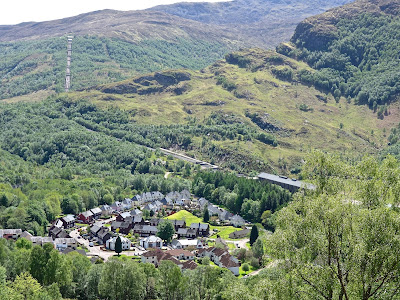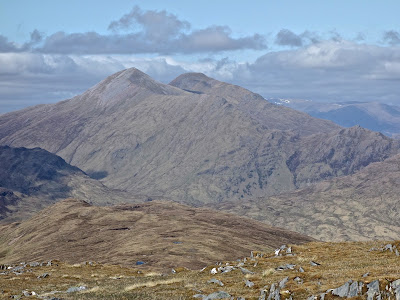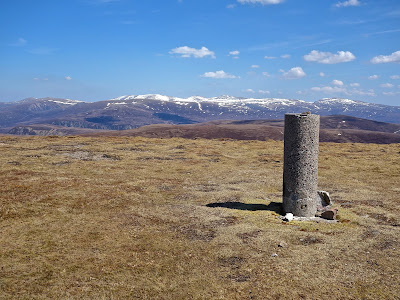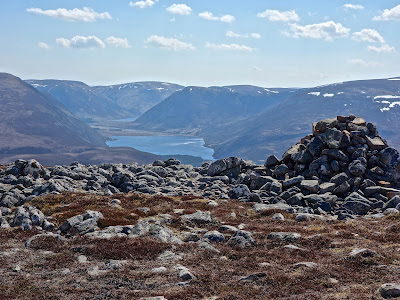 |
| Glen Feshie |
Monday, 9 May 2016
Ascent: 1670 metres
Distance: 41 kilometres (14 by bike 27 walking)
Time: 8 hours 26 minutes
Bike ride to ruin 405m 47minutes
Leathad an Taobhain 912m 2hrs 54mins
Meallach Mhor 769m 5hrs 6mins
Carn Dearg Mor 857m 6hrs 50mins
Collect bike 405m 7hrs 50mins
Summer had arrived and it seemed like a good occasion to tackle the three Corbetts at the head of Glen Feshie. At this time of year, it is possible as a day excursion with 5 hours of driving and, I assumed optimistically, 8 hours on the cycle/walk. I left home at 7am, hoping to clear the Broxden roundabout at Perth before the morning queues. Despite hitting it at 7:45am, there was still a 10-minute delay. The A9 was its usual dastardly self. Too early for the motor homes but lots of lorries, observing the average speed cameras by travelling at the 50mph limit. There were long tails of traffic behind the commercial lifeblood to the Highlands. I turned off at Kingussie to follow the old A9 road and found myself travelling much faster than the traffic on the A9 trunk road that runs in parallel with the old road.
At Kincraig I followed the road around Loch Insh, it was mesmerising in the morning light and, after turning up the Glen Feshie road and passing the glider airfield, I was in the car park before Auchlean by 9:30am. It took a few minutes to assemble the bike that I prefer to carry in the boot rather than on a bike rack and then to gather and pack my walking gear. The cycle up glen was fine until the burn that you have to cross about 2 kilometres up from the car park. It was too deep to keep dry feet. I was a bit perplexed by the notice on the gate explaining that the old footbridge had finally collapsed and the nearest one was 2.7 kilometres "downstream" Did I have to go back? I was sure I could see the new bridge ahead. I dug out the map to check the stated grid reference of the new bridge on the public notice and was relieved that the new bridge was the one ahead.
Glen Feshie is a glorious glen, one of the few places that I have seen a wildcat when I had camped late on a Friday evening and watched a wildcat saunter past the tent early the next morning. The river was running high with all the snowmelt and the footbridge gave a close-up view of the raging torrent. The road across the river on the west side runs up to the cottages at Carnachuin and then on to Feshie Lodge. The road is metalled and in perfect condition, even with a fresh breeze and the gradient against me, it was an easy ride. Beyond the lodge, the road deteriorates into a rough stone track but the gradient allows for a steady pedal up to the ruin at a junction where 3 horses were grazing. I turned right and began the ascent up to Lochan an t-Sluic. At the top of the plantation, the gradient became too steep for continued cycling so I dumped the bike and began the walk.
It is 6.5 kilometres up a gravel track to Meall an Uilt Chreagach and then another 1.5 kilometres to the Corbett of Leathad an Taobhain. It is only 1 metre short of being a Munro. Apart from a plantation beyond the Lochan, it is a landscape of rounded hills and heather. I caught up with another walker at about 750 metres, he asked me where he was and discovered that he had taken the wrong turning at the ruin. He would have to walk back 6 kilometres and then cross the river to continue his walk to Braemar. I briefly thought about suggesting a more direct route but the terrain would be difficult and I doubted if his map reading skills were up to it. The summit of the hill is a bit of an anti-climax: a lone Vanessa trig point squatting on a flattish heather and dry grassy hillock but with fine views to the Cairngorms. I continued to the nearby 902m top and then took a north-westerly route down steep slopes to find the Minigaig drover's road. It has fallen into disuse and largely follows boggy ground until it joins the Allt Coire Bhran. After 3 kilometres of trying to keep my feet dry and crossing dozens of small burns, I was glad to strike up a slope in the direction of Meall an Dubh-chadha, the outlying top of Meallach Mhor.
It was a long slog and there were extensive peat hags separating the twin peaks. It is times like this that I walk on automatic pilot, just find a pace that allows me to grind out the climb without any rests until the summit. It was a beautiful afternoon, the views were good particularly to the Loch an t Seilich and the Gaich pass to the south. I had some lunch before beginning the next leg of the walk. This required a descent to the peat hags again and then a steady climb to the summit of Meall an Dubh-chadha. From here I headed for the plantation and found a track made by an eight-track vehicle that transported "sportsmen" to the shooting butts.





























































